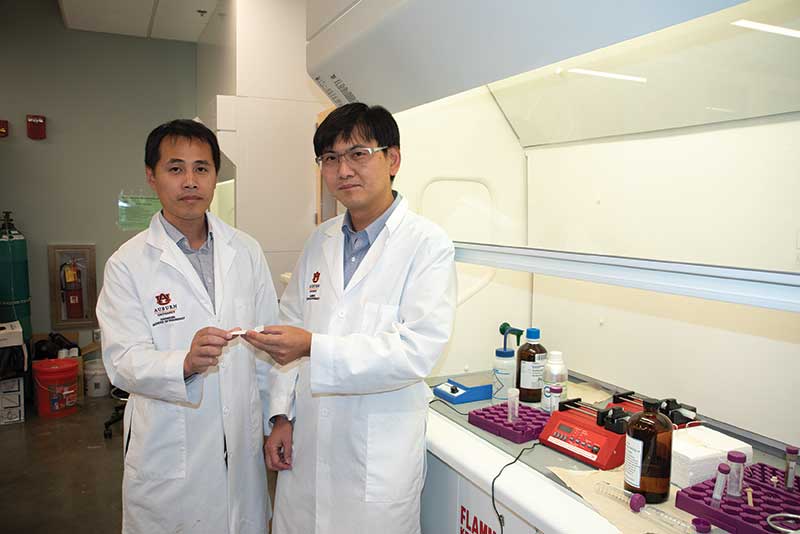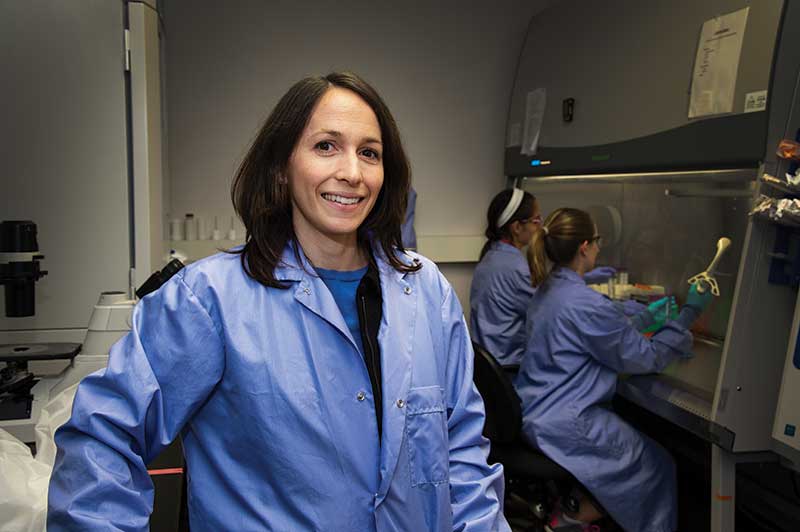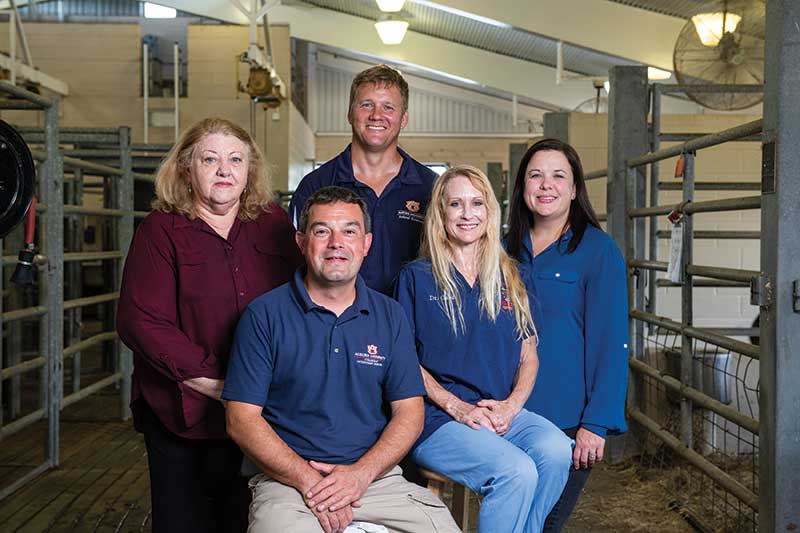LAUNCH funds next-level research
Article body
LAUNCH is an endowed fund conceived by the Auburn University Research and Economic Development Advisory Board as a mechanism to bridge the gap between innovative research and the marketplace. Milestone-based awards are given to winning teams who complete a competitive process involving a two-stage evaluation of proposals by internal and external parties, followed by a live presentation before judges and the public. The fund was created in 2015 with the goal of creating an endowment of $10 million that will generate some $400,000 annually for research grants. Until this endowment is fully funded, the Office of the Vice President for Research & Economic Development supplies these awards.
Three Auburn research programs recently were recognized as recipients of LAUNCH funding.
‘SMILE Plus’ moving toward efficient production of novel treatment for drug-resistant cancers
Feng Li, an assistant professor in the Department of Drug Discovery and Development in Auburn University’s Harrison School of Pharmacy, is approaching a method for efficiently producing a novel drug formulation found to be effective in treating drug-resistant cancers.
His research project, “SMILE Plus: A Nanoparticle Drug Formulation for Cancer Therapy,” is among three projects recently recognized as winners in AU’s LAUNCH program. His focus is to develop an efficient manufacturing method based on an existing FDA-approved drug for treating alcoholism that recently was discovered to also have cancer-fighting properties, into a nanoparticle complex that can treat cancers that are resistant to drug therapy. Li is particularly focused on effective drug therapy for fighting prostate cancer that becomes drug resistant over time as the disease progresses among stages.
“Prostate cancer is the most common type of cancer in men,” Li said. “About one in 41 will die of prostate cancer, and almost all patients eventually develop drug-resistant prostate cancer. Moreover, there presently is no effective treatment for drug-resistant prostate cancer.”
Li adds that a drug presently on the market and commonly used to treat alcoholism has been found to also be effective in treating cancer. The drug, Disulfiram, discovered by accident, has proven to be effective in killing cancer cells.
Li cites a study involving a 38-year-old cancer patient who had reached an advanced stage: “The cancer had spread into the bones,” Li said. “This normally is a fatal turn of events. The patient became an alcoholic, and doctors stopped all cancer treatment, instead, giving the patient Disulfiram, to discourage drinking.”
The patient survived 10 more years, perishing not of cancer, but in a fall, Li continues. An autopsy surprisingly revealed that the cancer was gone.
“The bone tumors had melted away, and only a few cancer cells were found to be in the bone marrow,” Li said.
Further studies on cancer patients taking Disulfiram found that the death rate from cancer dropped 34 percent. Disulfiram also was found to be effective in treating those types of cancers that are prone to become drug resistant as the cancer progresses.
The problem, however, is that Disulfiram has to be combined into a compound with copper to be most effective as a cancer treatment. No formulation was available for Disulfiram copper combination therapy.
Part of Li’s research involves development of a method to manufacture the cancer therapy nanoparticle complex on a large, commercial scale. With the assistance of Pengyu Chen, assistant professor in materials engineering, Li is working not only to perfect the nanoparticle complex as an injectable prostate cancer treatment therapy for clinical use but also to develop an effective large-scale manufacturing technology.
Their development, using 3-D printing manufacturing technology, already has progressed to a patent pending technology. Li says that animal testing is projected to begin this year using the SMILE Plus nanoparticle formulation.
Researchers developing efficient, cost-effective microfluidic production platform
Stem-cell therapy is becoming a common way of treating a variety of medical injuries and conditions. Stem-cell therapy uses cells from the patient’s own body to repair and speed up wound healing and tissue regeneration. Although it is proven to be effective, it is not without challenges.
One of the most significant challenges is having an efficient method for delivering these stem cells to the targeted area of treatment. Dr. Elizabeth Lipke, the Mary and John H. Sanders Associate Professor in the Department of Chemical Engineering, is among three winners of Auburn’s LAUNCH program. The award recognizes her research and developments in creating engineered biomaterials as hydrogels. These hydrogels are formed using a novel, injectable microfluidic platform that has been found to effectively encapsulate stem cells in a hydrogel microsphere at a much faster rate and at higher cell densities than previously achieved.
Cell-laden microfluidic devices have potential for downstream commercial applications, Lipke explained. However, most current microfluidic systems require costly fabrication facilities and can only produce small microspheres with low cell densities and slow production rates using limited types of materials.
“Our work is developing a faster and more efficient and cost-effective platform,” Lipke said. “Our LAUNCH proposal is focused on employing our microsphere production platform to advance high-throughput drug screening. Current drug screening is highly inefficient with most identified compounds failing to provide the desired clinical outcomes.
Challenges include the use of 2D cell sheets, which do not reflect the complex cellular microenvironment and do not provide enough cells to carry out desired assays, and self-aggregated cell spheroids, which can be highly variable and are not able to be formed for many cell types, including many metastatic cancer cell lines and patient-derived cancer cells.”
Lipke and Yuan Tian, a doctoral candidate in the Department of Chemical Engineering, have done extensive work with colleagues in other colleges at Auburn, particularly the College of Veterinary Medicine.
Lipke and veterinary collaborators have effectively used engineered hydrogels to treat equine distal injuries. Wound healing requires adequate blood flow to the affected area.
With horses suffering from distal wounds—the leg region below the knee and hock—this is a challenge, because the distal area is mostly comprised of bone and tendon.
There is not much muscle to carry blood to the wound to promote healing. Thus, such wounds are often difficult to heal.
Through this collaboration, the researchers have employed Lipke’s engineered hydrogels with great success, and through the LAUNCH initiative, Lipke’s research will focus on building a commercial prototype cell encapsulation device; carrying out high-throughput drug screening preliminary studies; use of these microspheres as a bioink for bioprinting; and use of these microspheres to support therapeutic cell delivery.
“The engineered biomaterials are hydrogels that we are developing in our lab,” Lipke said. “They protect and hold those stem cells together after injection to ensure that they reach their target and remain intact in order to form the type of regenerative cell desired.”
Although this therapy structure is microscopic, the example used simplistically to illustrate its appearance is a gelatin fruit salad. “Think of the fruit as the stem cells and the gelatin as the hydrogel scaffolding that holds them intact,” Lipke said.
Lipke’s research developments have established a microfluidic platform that is customizable and sustainable, with improved control and flexibility over current methods. These characteristics should prove to be a cost-effective method for commercial application.
Veterinary Medicine faculty recognized for trich research to help cattle industry
A College of Veterinary Medicine faculty research group was one of three Auburn teams recognized by Auburn University for an innovative treatment that could significantly impact the cattle industry in Alabama and worldwide.
The CVM team has created an extended release, novel topical formulation of an approved drug to treat the infectious reproductive disease Trichomoniasis in cattle.
Trichomoniasis, commonly referred to as trich, is a venereal disease in cattle caused by the protozoa organism, Tritrichomonas foetus. This small organism is found only in the reproductive tract of infected bulls which can spread to cows resulting in loss of calves. Infected cattle can lead to major economic losses due to infertility, low pregnancy rates, an extended calving season and diminished calf crops.
College of Veterinary Medicine faculty Drs. Sue Hudson Duran, Julie Gard Schnuelle and Thomas Passler, as well as Soren Rodning, extension veterinarian and associate professor in the Department of Animal Sciences, were recognized. Additionally, Dr. Misty Edmonson, associate state veterinarian, and Dr. Jennifer Koziol, now at Purdue University, and Dr. Larisa Niehaus were involved in the project.
Duran, RPH, MS, PhD, DICVP, is a 44-year faculty member and professor emerita in the Department of Clinical Sciences and an adjunct professor in the Harrison School of Pharmacy. She recently retired but continues to work on contract. Dr. Kelly Joiner and Dr. Jennifer Spencer worked in the lab with Duran and the other team members for seven years including Merck Merial student Larisa Niehaus and graduate student Jennifer Koziol. Previous research included testing 12 different drugs for the most efficacious formulation. The funds will now aid the team to study the combined drugs and extended release formulas on bulls for the right dosages needed for appropriate treatment.
Duran was invited as a keynote speaker to China in 2015 at the BIT’s 5th Annual World Symposium on Drug Delivery Systems to present her work with extended release polymers as well as several other U.S. programs. This program brought together 350 scientists and researchers in academia and industry for innovative DDS technology. The university has sought a provisional patent on the team’s work.
With the U.S. being the largest cattle producer in the world (94.3 million annually), and cattle production is an $80 billion industry, the group’s findings could have a significant impact to the cattle industry in the U.S. and worldwide as well.
There currently is no effective treatment and in some cases, the disease causes an entire herd, including the bull, to be put down. If one bull is infected with trich, as many as 80-90 percent of cows can be affected, which would destroy a cattle crop. The cost of prize bulls may $250,000, so the loss of this investment can have a devastating impact on a cattle farmer.
This funding will allow faculty to extend clinical trials of the treatment to more diseased animals to determine the efficacy of the research.
This new extended release topical formulation has shown that it will help the drug penetrate the tissues better and faster as well as extend the release of the drug, so it does not have to be applied daily.
Auburn University is a nationally ranked land grant institution recognized for its commitment to world-class scholarship, interdisciplinary research with an elite, top-tier Carnegie R1 classification and an undergraduate education experience second to none. Auburn is home to more than 30,000 students, and its faculty and research partners collaborate to develop and deliver meaningful scholarship, science and technology-based advancements that meet pressing regional, national and global needs. Auburn's commitment to active student engagement, professional success and public/private partnership drives a growing reputation for outreach and extension that delivers broad economic, health and societal impact. Auburn's mission to educate, discover and collaborate drives its expanding impact on the world.




